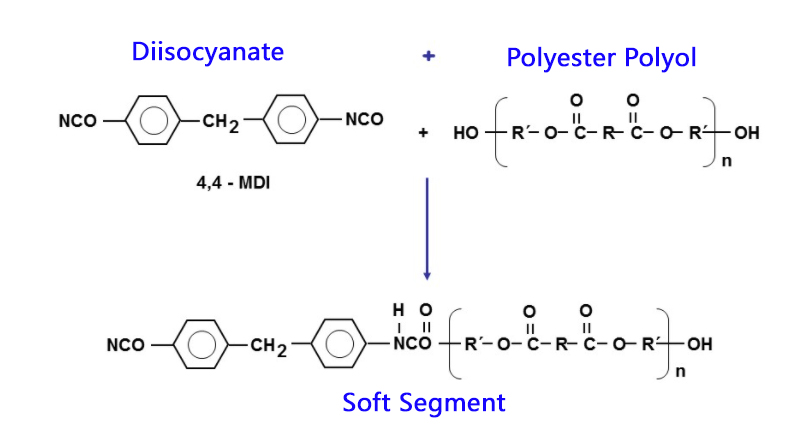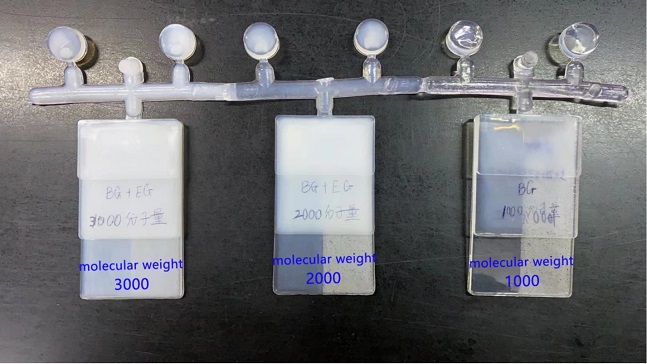Polyurethane is a general term for macromolecular compounds containing repeating carbamate groups (-NHCOO-) on the main chain. It is a polymer made from many kind of raw materials. By changing the type of polyurethane resin raw materials and the composition of the formula, the polyurethane resin properties can be greatly changed. The upstream raw materials of polyurethane include isoflurane (such as diphenylmethane diisofluorate, MDI; toluene diisocyanate, TDI), polyester polyol (generated by the reaction of polyol and polyacid, polyacid commonly is Adipic acid, AA; polyols commonly is butanediol, BG, ethylene glycol, EG), polyether polyols, etc., auxiliary materials include solvents (such as dimethylformamide, DMF), chain extenders, catalysts, foaming agent, etc. Therefore, polyester polyols are generally divided by polyol types, including pure EG polyester polyols, pure BG polyester polyols, EG/BG polyester polyols, EG/DEG polyester polyols, etc. Different mixing ratio of polyols resulting polyester polyols with different properties. Polyester polyols with different properties will also resulting TPU with different properties.

Molecular weight AA=146.14; BDO=90.1; EG=62.1; DEG=106.1; PG=76.1; NPG=104.1; MPD=90.8; HDO=118.
(1) Pure EG polyester polyol:
When the molecular weight of polyester polyol is 1000, the AA content is about 0.67, and the EG content is about 0.33;
When the molecular weight of polyester polyol is 2000, the AA content is about 0.68, and the EG content is about 0.32;
When the molecular weight of polyester polyol is 3000, the AA content is about 0.69, and the EG content is about 0.31;
The AA content of pure EG polyester polyol is around 0.67-0.69, and the EG content is around 0.31-0.33. As the molecular weight of polyester polyol increases, the adipic acid content increases, and the EG content decreases.
(2) Pure BG polyester polyol:
When the molecular weight of polyester polyol is 1000, the AA content is about 0.57, and the BDO content is about 0.43;
When the molecular weight of polyester polyol is 3000, the content of AA is about 0.60, and the content of BDO is about 0.40;
The AA content of pure BG polyester polyol is around 0.57-0.60, and the BDO content is around 0.40-0.43. It can also be concluded that with the increase of the molecular weight of polyester polyol, the content of adipic acid increases, The BDO content decreased along with it.
(3) Pure DEG polyester polyol:
When the molecular weight of polyester polyol is 1000, the AA content is about 0.53, and the DEG content is about 0.47;
When the molecular weight of polyester polyol is 2000, the AA content is about 0.55, and the DEG content is 0.45;
When the molecular weight of polyester polyol is 3000, the AA content is 0.56, and the DEG content is 0.44;
The AA content of the pure DEG polyester polyol is around 0.53-0.56, and the DEG content is around 0.44-0.47. With the increase of the molecular weight of the polyester polyol, the adipic acid content increases, and the DEG content decrease with the increase of the molecular weight.
Therefore, we can draw the following conclusions: when the relative molecular weight of diols is constant, with the increase of the molecular weight of polyester polyols, the content of adipic acid gradually increases, and the content of diols gradually decreases. The larger the molecular weight of the polyol, the worse the transparency of TPU and the faster cycle times in TPU products processing. TPU made by pure EG polyester polyol is more easily fogging and migration than that made by pure BG polyester polyol. TPU made by EG+BG polyester polyol is with the best fogging and migration behavior.
